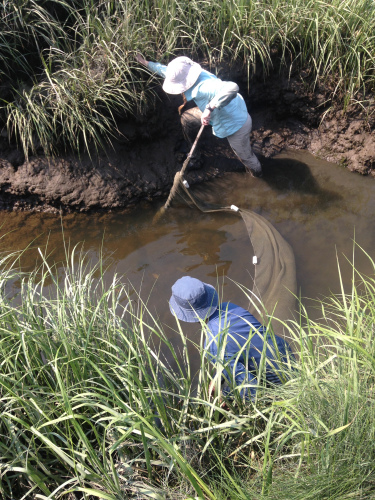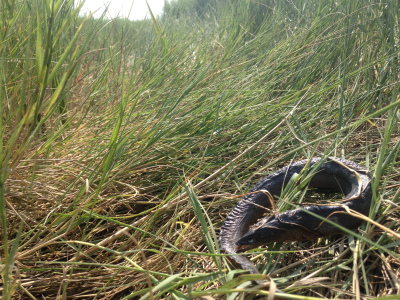 New England’s salt marshes were some of the first ecosystems I was immersed in (literally) as I began my jaunt into marine science. For many people, the draw is their tranquility, as looking out onto a cordgrass meadow gently rippling in the breeze can be quite relaxing. Something that fascinated me then, and still does now, is how these peaceful feelings can be evoked by such a harsh environment. Large, strong tides, cold, salty water, and hot, unrelenting sun all represent real hazards for animals residing in these coastal margins. Yet salt marsh critters don’t run from these dangers: in fact, food webs in these areas are designed to meet stressors head on, taking life-threatening risks in order to reap the energetic rewards that pushing these boundaries can provide.
New England’s salt marshes were some of the first ecosystems I was immersed in (literally) as I began my jaunt into marine science. For many people, the draw is their tranquility, as looking out onto a cordgrass meadow gently rippling in the breeze can be quite relaxing. Something that fascinated me then, and still does now, is how these peaceful feelings can be evoked by such a harsh environment. Large, strong tides, cold, salty water, and hot, unrelenting sun all represent real hazards for animals residing in these coastal margins. Yet salt marsh critters don’t run from these dangers: in fact, food webs in these areas are designed to meet stressors head on, taking life-threatening risks in order to reap the energetic rewards that pushing these boundaries can provide.
I am here studying Plum Island’s food webs. One of the major cogs in the always-churning ecosystem machine is the mummichog, a small minnow that easily dominates the other marsh critters in terms of sheer numbers of individuals residing in the creeks. You can catch these baitfish by the hundreds in all sorts of traps and nets, and though they can eat a plant-based diet, in order for them to truly grow big and strong, they need some protein! Big fish can eat the shrimp and invertebrates found in the creeks, but how can a mummichog get to that size in the first place? The answer is by risking life and fin and riding the tide up to the dangerous high marsh, to snack on unsuspecting insects and spiders. Seems crazy, but the risk of getting stranded up there, or eaten by a bird or other predator, is definitely worth it for the potential energetic boost they can get. In this way, mummichog function as an incredibly important link between these two (high marsh and creek) distinct habitats, gathering energy in the form of food produced in the high marsh (insects and spiders) and making it available to the consumers we all love, like striped bass and flounder in the creek. Not bad for such a little guy!
 One of the most interesting effects of increased nutrient load on these coastal systems is the sloughing and disintegration of the low marsh area of the creeks, which normally act as a ramp for these mighty minnows to make their daring climb. How does the loss of that ramp affect the mummichog’s ability to bridge the two ecosystems, and what does a change in the strength of that link mean for the creek’s other residents? How does the ecosystem respond to this decoupling of the creek and high marsh? These are the questions I’m hoping to answer this summer. As we head out to West Creek with our trusty seine net to collect fish, shrimp, and other marine critters for our analyses, we come across a dead American eel on the path, stranded as the tide receded and desiccated by the strong summer sun. Clearly, the high marsh bounty is worth risking everything for, and I hope to understand how that link, and its loss, drives the function and long-term stability of these “peaceful” ecosystems.
One of the most interesting effects of increased nutrient load on these coastal systems is the sloughing and disintegration of the low marsh area of the creeks, which normally act as a ramp for these mighty minnows to make their daring climb. How does the loss of that ramp affect the mummichog’s ability to bridge the two ecosystems, and what does a change in the strength of that link mean for the creek’s other residents? How does the ecosystem respond to this decoupling of the creek and high marsh? These are the questions I’m hoping to answer this summer. As we head out to West Creek with our trusty seine net to collect fish, shrimp, and other marine critters for our analyses, we come across a dead American eel on the path, stranded as the tide receded and desiccated by the strong summer sun. Clearly, the high marsh bounty is worth risking everything for, and I hope to understand how that link, and its loss, drives the function and long-term stability of these “peaceful” ecosystems.
– Justin Lesser
David S Johnson
An excellent and well-written post, Justin. I felt like I was there. Good luck with studying the charismatic megafauna of the marsh. #muckyeah!
~David J